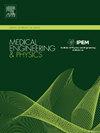Can we identify stroke sub-type without imaging? A multidimensional analysis
IF 2.3
4区 医学
Q3 ENGINEERING, BIOMEDICAL
引用次数: 0
Abstract
Stroke is a major cause of mortality and disability worldwide, with ischemic stroke (AIS) and intracerebral haemorrhage (ICH) requiring distinct management approaches. Accurate early detection and differentiation of these subtypes is crucial for targeted treatment and improved patient outcomes. Traditionally, imaging techniques such as computed tomography (CT) and magnetic resonance imaging (MRI) are required to distinguish between AIS and ICH. However, this study explores a non-imaging approach to differentiate between stroke subtypes. Using a retrospective dataset of 80 mild-to-moderate patients suffering stroke (68 AIS and 12 ICH), we employed principal component analysis (PCA) combined with logistic regression (LR) to evaluate 67 parameters. These parameters include baroreceptor sensitivity, and cerebral and peripheral hemodynamic variables. The PCA-LR model, validated through two-fold and six-fold cross-validation methods, effectively differentiated between AIS and ICH. BRS parameters and cerebral hemodynamic factors contributed significantly to the model’s accuracy. The two-fold cross-validation approach achieved an area under the curve (AUC) of ≥0.92, while the six-fold method maintained a consistent variance explanation (AUC ≥0.79). Results suggest that this multidimensional approach may facilitate early stroke subtype identification (AIS vs ICH) without reliance on imaging, offering a promising tool for ultra-acute stroke care in prehospital settings. However, it is important to note that the model has been tested in confirmed stroke cases, and its ability to distinguish between stroke and stroke mimics remains an important limitation for broader clinical application. Future research with larger datasets is warranted to refine the model and validate its clinical applicability.
我们能在没有影像学的情况下识别脑卒中亚型吗?多维分析
卒中是世界范围内死亡和残疾的主要原因,缺血性卒中(AIS)和脑出血(ICH)需要不同的治疗方法。准确的早期检测和区分这些亚型对于靶向治疗和改善患者预后至关重要。传统上,需要计算机断层扫描(CT)和磁共振成像(MRI)等成像技术来区分AIS和ICH。然而,本研究探索了一种非成像方法来区分脑卒中亚型。使用80名轻中度脑卒中患者(68名AIS患者和12名ICH患者)的回顾性数据集,我们采用主成分分析(PCA)结合逻辑回归(LR)来评估67个参数。这些参数包括压力感受器敏感性、脑和外周血流动力学变量。PCA-LR模型通过两重和六重交叉验证方法验证,有效区分了AIS和ICH。BRS参数和脑血流动力学因素对模型的准确性有显著影响。两重交叉验证法的曲线下面积(AUC)≥0.92,六重交叉验证法保持一致的方差解释(AUC≥0.79)。结果表明,这种多维方法可以促进早期卒中亚型识别(AIS与ICH),而不依赖于影像学,为院前超急性卒中护理提供了一种有前途的工具。然而,值得注意的是,该模型已经在确诊的中风病例中进行了测试,其区分中风和中风模拟的能力仍然是广泛临床应用的一个重要限制。未来的研究需要更大的数据集来完善模型并验证其临床适用性。
本文章由计算机程序翻译,如有差异,请以英文原文为准。
求助全文
约1分钟内获得全文
求助全文
来源期刊

Medical Engineering & Physics
工程技术-工程:生物医学
CiteScore
4.30
自引率
4.50%
发文量
172
审稿时长
3.0 months
期刊介绍:
Medical Engineering & Physics provides a forum for the publication of the latest developments in biomedical engineering, and reflects the essential multidisciplinary nature of the subject. The journal publishes in-depth critical reviews, scientific papers and technical notes. Our focus encompasses the application of the basic principles of physics and engineering to the development of medical devices and technology, with the ultimate aim of producing improvements in the quality of health care.Topics covered include biomechanics, biomaterials, mechanobiology, rehabilitation engineering, biomedical signal processing and medical device development. Medical Engineering & Physics aims to keep both engineers and clinicians abreast of the latest applications of technology to health care.
 求助内容:
求助内容: 应助结果提醒方式:
应助结果提醒方式:


